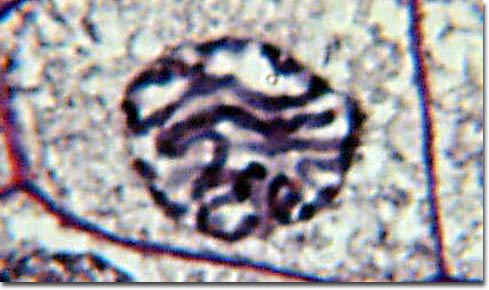The process by which a cell divides into two or more cells. Among prokaryotes, cell division occurs by simple fission. Among eukaryotes, the cell nucleus divides first, and then a new cell membrane is formed between the nuclei to form the new cell. Cell division is used as a means of reproduction in organisms that reproduce asexually, as by fission or spore formation, and sexually reproducing organisms form gametes through cell division. Cell division is also the source of tissue growth and repair in multicellular organisms. The two types of cell division in eukaryotic organisms are mitosis and meiosis.
Chromatid:
A chromatid is one of the paired chromosome strands, joined at the centromere, which make up a metaphase chromosome, resulting from chromosome reduplication during the S phase (DNA synthetic phase) of interphase.

Centromere:
The centromere is a constricted region of a mitotic chromosome that holds sister chromatid together. Also the site on the DNA where the kinetochores form and then capture microtubules from the mitotic spindle.

Interphase:
The stage in the cell cycle when the cell is not dividing and during part of which DNA replication occurs; it follows telophase of one mitotic division and extends to the beginning of prophase in the next division.

Cell Cycle:
Regulated biochemical steps that cells go through involving DNA replication and cell division, usually depicted as a sequential cyclical series of events.
Mitosis:
The process in cell division in eukaryotes in which the nucleus divides to produce two new nuclei, each having the same number and type of chromosomes as the original. Prior to mitosis, each chromosome is replicated to form two identical strands (called chromatids). As mitosis begins, the chromosomes line up along the center of the cell by attaching to the fibers of the cell spindle. The pairs of chromatids then separate, each strand of a pair moving to an opposite end of the cell. When a new membrane forms around each of the two groups of chromosomes, division of the nucleus is complete. The four main phases of mitosis are prophase, metaphase, anaphase, and telophase.
Prophase:
- The first stage of mitosis, during which the chromosomes condense and become visible, the nuclear membrane breaks down, and the spindle apparatus forms at opposite poles of the cell.
- The first stage of meiosis, during which the DNA replicates, homologous chromosomes undergo synapsis, chiasmata form, and the chromosomes contract.

Centriole:
Either of a pair of cylinder-shaped bodies found in the centrosome of most eukaryotic organisms other than plants. During cell division (both mitosis and meiosis), the centrioles move apart to help form the spindle, which then distributes the chromosomes in the dividing cell.

Spindle:
A spindle-shaped structure, composed of microtubules, that forms near the cell nucleus during mitosis or meiosis and, as it divides, draws the chromosomes to opposite poles of the cell.

Metaphase:
The stage of mitosis and meiosis, following prophase and preceding anaphase, during which the chromosomes are aligned along the metaphase plate.

Anaphase:
The stage of cell division in mitosis or meiosis in which the doubled set of chromosomes separates into two identical groups that move to opposite ends of the cell. Anaphase is preceded by metaphase and followed by telophase.

Telophase:
The final stage of meiosis or mitosis, in which the separated chromosomes reach the opposite poles of the dividing cell and the nuclei of the daughter cells form around the two sets of chromosomes.

Cytokinesis:
The division of the cytoplasm of a cell following the division of the nucleus during cell division.

Cyclin:
A class of proteins that fluctuate in concentration at specific points during the cell cycle and that regulate the cycle by binding to a kinase.

Cancer:
Any malignant growth or tumor caused by abnormal and uncontrolled cell division; it may spread to other parts of the body through the lymphatic system or the blood stream.


No comments:
Post a Comment